-
Paper Information
- Paper Submission
-
Journal Information
- About This Journal
- Editorial Board
- Current Issue
- Archive
- Author Guidelines
- Contact Us
International Journal of Networks and Communications
p-ISSN: 2168-4936 e-ISSN: 2168-4944
2024; 13(2): 28-33
doi:10.5923/j.ijnc.20241302.02
Received: Dec. 4, 2024; Accepted: Dec. 22, 2024; Published: Dec. 28, 2024

Congestion Control Approach During Transient Link Cost Updates in IP Networks
Simon Tembo1, Ken-Ichi Yukimatsu2, Shohei Kamamura3
1Department of Electrical and Electronic Engineering, University of Zambia, Lusaka, Zambia
2Department of Computer Science and Engineering, Akita University, Akita-shi, Akita, Japan
3Department of Computer Science, Seikei University, Musashino-shi, Tokyo, Japan
Correspondence to: Simon Tembo, Department of Electrical and Electronic Engineering, University of Zambia, Lusaka, Zambia.
| Email: |  |
Copyright © 2024 The Author(s). Published by Scientific & Academic Publishing.
This work is licensed under the Creative Commons Attribution International License (CC BY).
http://creativecommons.org/licenses/by/4.0/

When forwarding paths in an IP network are altered due to link failures or cost updates, preventing transient loops and link congestion is crucial for maintaining optimal network performance. To address the challenge of transient link congestions during simultaneous link cost updates— a significant challenge for ISPs, especially large-scale ones engaged in traffic engineering—we propose the Priority Link Cost Update Sequence Order method. This approach prioritizes updates on heavily loaded links, redistributing traffic more efficiently to reduce peak link loads and stabilize performance within capacity limits. The core of our algorithm lies in identifying these heavily loaded links and systematically directing traffic to less congested alternatives, effectively mitigating transient congestion and ensuring stable network operations during the update process. The results highlight its potential to enhance reliability and sustain service quality under dynamic link cost changes.
Keywords: Transient Loops, Link Costs, High Load Link, Maximum Load, Link overflow, Congestion Control
Cite this paper: Simon Tembo, Ken-Ichi Yukimatsu, Shohei Kamamura, Congestion Control Approach During Transient Link Cost Updates in IP Networks, International Journal of Networks and Communications, Vol. 13 No. 2, 2024, pp. 28-33. doi: 10.5923/j.ijnc.20241302.02.
Article Outline
1. Introduction
- IP networks are foundational to modern communication systems, enabling efficient data transfer between devices across vast and distributed infrastructures. These networks use protocols such as Open Shortest Path First (OSPF) to determine optimal routes for packet delivery based on link costs, which represent the cost of transmitting data across network links. In such systems, dynamically updating link costs during periods of congestion or evolving traffic patterns presents a significant challenge for network operators, particularly in ensuring the avoidance of transient forwarding loops and maintaining high-quality performance metrics such as delay, connectivity, and throughput.A review of the literature highlights various approaches and strategies for link cost optimization in OSPF-based IP networks. Previous studies have shown that progressively increasing (equation 1) the Interior Gateway Protocol (IGP) link cost of a congested link can effectively remove it from traffic routing while avoiding transient loops [1,3,4,8,9,14]. Research also indicates that systematically increasing the link cost to a sufficiently large value ensures that the link can be safely shut down without disrupting network stability [1,9]. Additionally, minimizing the maximum link load across a network has been identified as a critical objective in optimizing network performance and resource utilization [1,2,9,22]. Several studies have proposed traffic engineering strategies to reroute traffic dynamically, often leveraging Shortest Path First (SPF) computations to determine alternative paths and distribute traffic more evenly [10,16]. Despite these advancements, challenges remain in developing methods to manage link overflow effectively during transient link cost updates.
 | (1) |
 is the initial link cost and
is the initial link cost and  is the new cost.In this paper, we present an innovative approach to control link overflow during transient link cost updates in IP networks. Our method employs a brute-force algorithm to generate permutations of link cost update sequences and identify patterns that maintain loop avoidance and network stability. Using matrix operations, we represent the initial topology (aij), the required link cost updates (bij), and the target topology (zij), which corresponds to the state of 100% optimum routing. By adhering to loop avoidance rules [1,9,11,17], we iteratively update link costs to achieve the desired target topology, as illustrated in Figure 1.
is the new cost.In this paper, we present an innovative approach to control link overflow during transient link cost updates in IP networks. Our method employs a brute-force algorithm to generate permutations of link cost update sequences and identify patterns that maintain loop avoidance and network stability. Using matrix operations, we represent the initial topology (aij), the required link cost updates (bij), and the target topology (zij), which corresponds to the state of 100% optimum routing. By adhering to loop avoidance rules [1,9,11,17], we iteratively update link costs to achieve the desired target topology, as illustrated in Figure 1.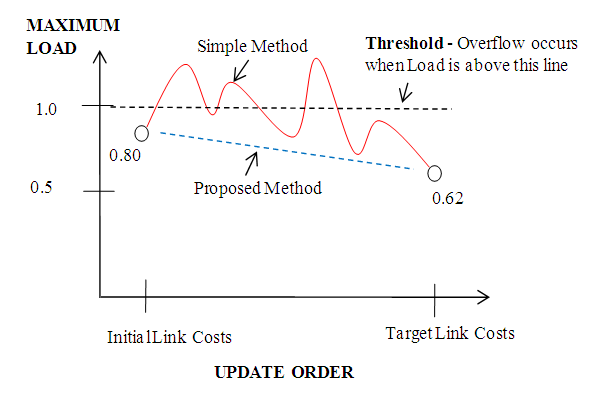 | Figure 1. Model of Performance Evaluation |
2. Problem Statement
- This section provides an illustrative example to demonstrate how link overflow can occur during the transient process of updating link costs. As shown in Figure 2, employing the route optimization method [2,3], the issue of link overflow on link 3-7 during the transient state can be avoided by carefully determining the sequence of link cost updates.
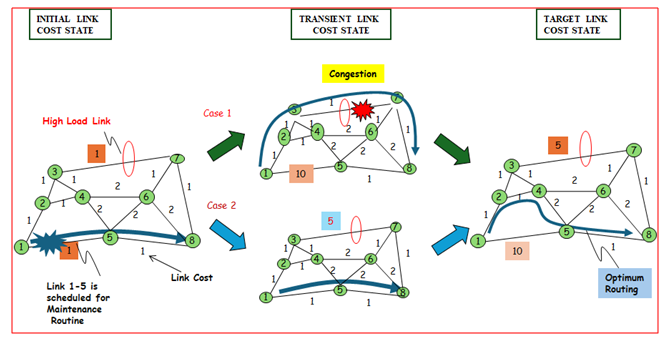 | Figure 2. Simple Model –To Illustrates Permutation Problem |
|
3. Proposed Link Cost Update Sequence Order Method
- This section provides an overview of the application of our algorithm to control link overflow in IP networks. The proposed Link Cost Update Sequence Order (LCUSO) method is a targeted approach that effectively addresses the challenge of congestion by minimizing the maximum load across the network through strategic link cost updates.At the core of the LCUSO method is the precise identification of High Load Links and High Load Nodes, which are critical in determining areas of congestion within the network. Once identified, a forwarding tree is constructed to strategically select specific links connected to leaf nodes for cost adjustments. By carefully redistributing traffic away from overloaded links to underutilized ones, the algorithm achieves a balanced load distribution across the network.The LCUSO method’s efficiency lies in its ability to make dynamic and accurate adjustments based on real-time network conditions. This ensures not only the alleviation of link congestion but also the optimization of overall network performance, highlighting the reliability and practicality of the approach in modern IP network management.
3.1. Overview of the LCUSO Method
- We provide an overview of our approach. The input data comprises the network topology with predefined initial link costs, specified target link costs, and the traffic matrix. Utilizing the Brute Force method, we generate permutations of link cost updates to identify sequence order patterns. To guarantee compliance with the loop avoidance condition [1,3,4,8,11,13,20], we employ matrix addition rules (aij+bij=zij) to execute the link cost updates during matrix operations.
4. Performance Evaluation
4.1. Simulations Conditions
- In our evaluation, we use the COST 239 topology model (i.e. an actual European network) [12,15] illustrated in Figure 3 and updatable links (Table 1). In this paper we set the link capacity to be uniform for all links in the network model. We use a gravity model type of traffic demand according to the population distribution.
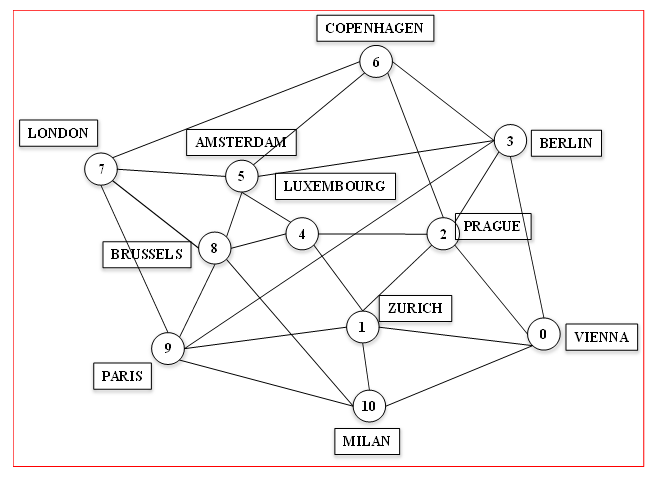 | Figure 3. European Network Model - COST 239 [12,15] |
5. Results and Discussion
- In this paper, we define the optimum routing when we achieve the minimum maximum link utilization during the transient period of link cost updates. Link overflow occurs when the transient maximum load exceeds that of the initial state. We use Brute Force approach to determine the update sequence order for all permutations results.
5.1. Results with Link Overflow
- In this paper, we aim to validate the effectiveness of our approach to controlling network congestion. To achieve this, we begin our simulations with a network in an initial state of congestion. To demonstrate the robustness of our method, we examine two distinct network congestion conditions, with optimum routing performances of 12.5% and 0%, as illustrated in Figures 4 and 5, respectively.
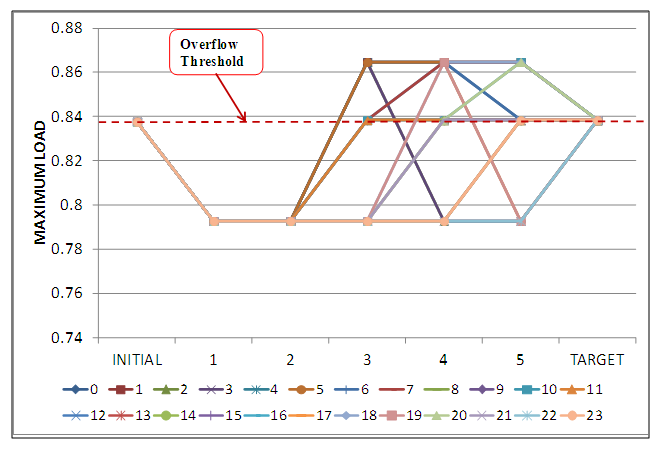 | Figure 4. Congestion Condition occurs with 12.5% Optimum Routing |
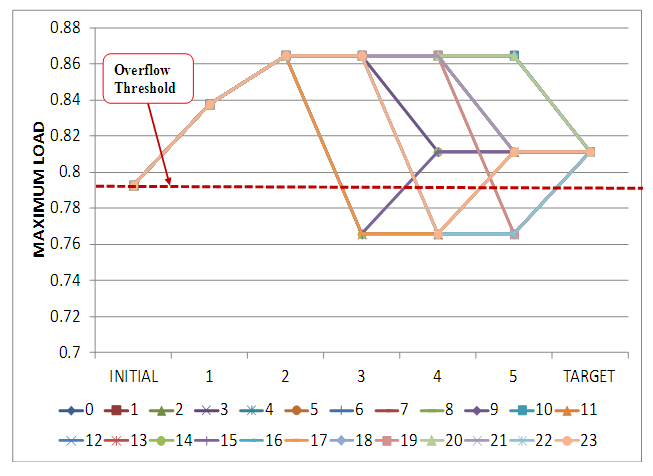 | Figure 5. Congestion Condition 0% Optimum Routing |
5.2. Use of Random Selection Method to Select Links for Link Cost Updates
- In this paper, we employ the "Random Selection Method to select Links for Link Cost Updates," as a process in which network links are chosen at random for cost updates. This approach does not adhere to any specific pattern or criteria, relying instead on randomness to determine which links are updated. The main objective of this method is to introduce a stochastic or unbiased element into the link update process, simplifying implementation in some cases and providing a baseline for evaluating the performance of the proposed LCUSO method.In this section, we demonstrate the effectiveness of both congestion control methods under existing network congestion conditions by updating link costs for both the Random Selection Method and the LCUSO Method. We start by highlighting the effectiveness of the Random Selection approach.Following this, we present the link selection method for updates, designed to efficiently manage link overflow during transient link cost updates, thereby validating the implementation of our proposed LCUSO method.We conducted simulations using the Random Selection method for both network scenarios, with initial congestion levels as depicted in Figures 4 and 5. Despite using Random Selection to mitigate congestion, the evaluation after the simulation indicated that link overflow occurred during the transient phase, as shown in Figures 6 and 7.
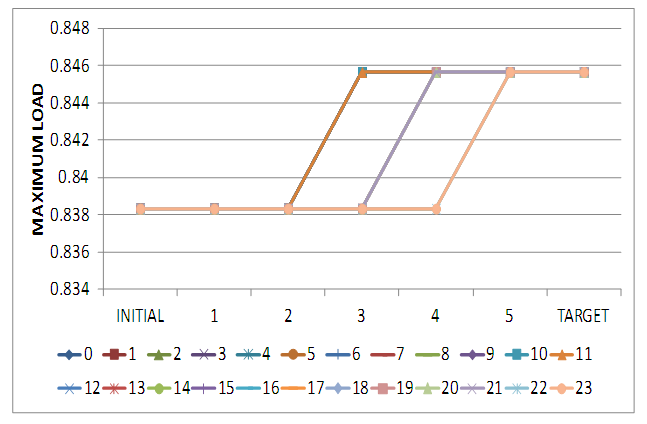 | Figure 6. Results for Random Selection Method as a Congestion Control of Congestion in Figures 4 |
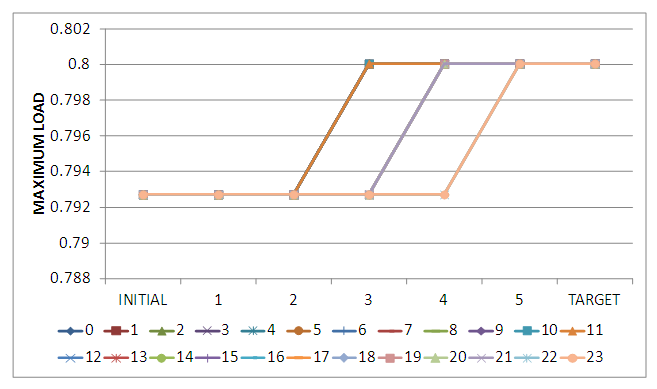 | Figure 7. Results for Random Selection Method as a Congestion Control of Congestion in Figure 5 |
5.3. Use of Link Cost Update Sequence Order (LCUSO) Method to Select Links for Link Cost Updates
5.3.1. Algorithm Overview
- In this section, we introduce the algorithm developed to efficiently prevent link overflow during transient link cost updates, highlighting the implementation of our proposed Link Cost Update Sequence Order (LCUSO) method. This method effectively identifies links for cost updates, significantly reducing the maximum load in the network. The approach focuses on detecting the High Load Link and High Load Node, and subsequently building a forwarding tree that prioritizes cost updates for links connected to leaf nodes. This ensures efficient redistribution of traffic from overloaded links to alternate paths within the network. The LCUSO method, therefore, offers a systematic and precise process for selecting links for cost updates. Figure 8 presents the algorithm's flowchart, outlining each step and emphasizing the robustness of our approach.
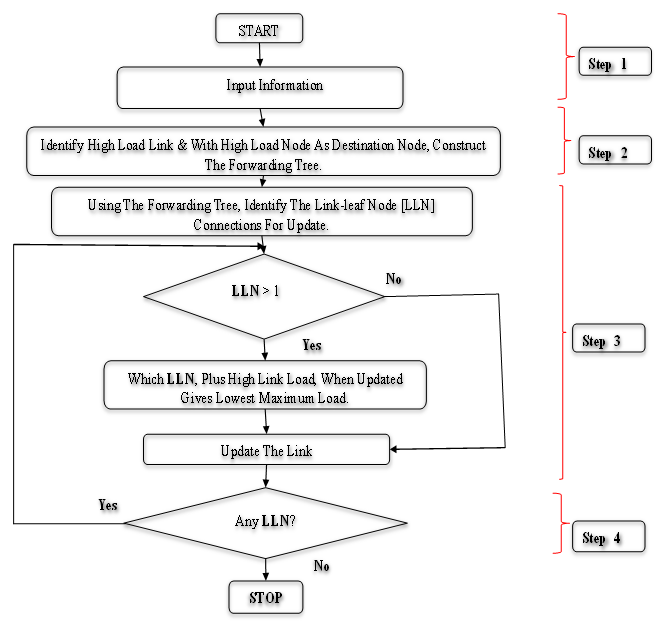 | Figure 8. Flowchart of LCUSO Method |
5.3.2. Simulation Results and Performance Evaluation of the Proposed LCUSO Congestion Control Method
- In this section, we present the simulation results without link overflow during the transient link cost updates as shown in figures 9. The simulation results affirm the successful application of our proposed LCUSO method, as demonstrated in Figures 9, where no link overflow occurs during transient link cost updates. By employing the LCUSO method, we effectively identify the links requiring updates and, subsequently, utilize the Brute Force approach to determine the optimal update sequence from all possible permutations. This methodology underscores the robustness and precision of our approach in managing transient link updates efficiently. Figure 9 presents the simulation results obtained using the proposed LCUSO method for a network under the congestion conditions depicted in Figure 4. The results indicate that no link overflow occurs throughout the network, highlighting the method's effectiveness.
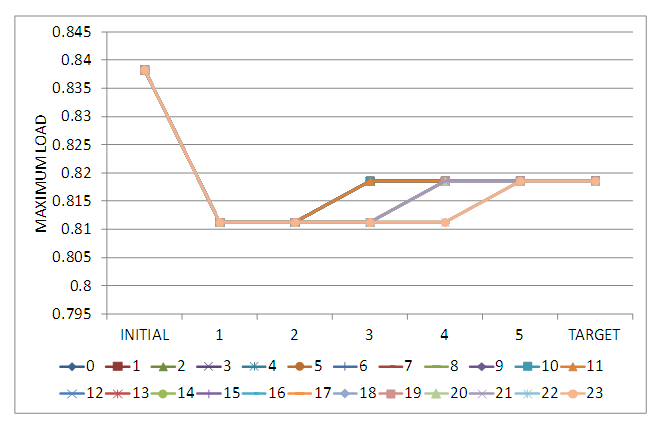 | Figure 9. Results for LCUSO Method of Network Condition in Figure 4 with No Link Overflow and achieving 16.7% Optimum Routing |
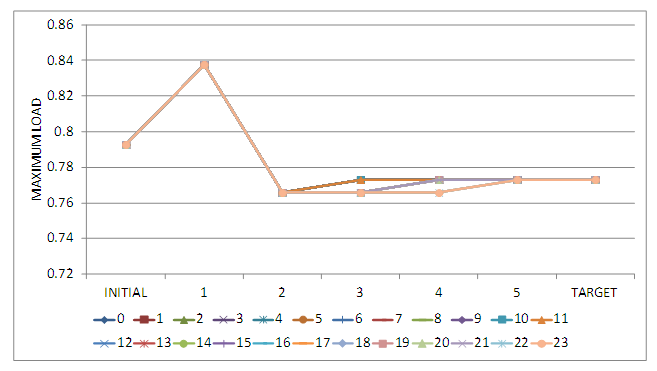 | Figure 10. Results for LCUSO Method of Network Condition in Figure 8 with No Link Overflow after the second link cost update |
6. Conclusions
- We have introduced and validated a Link Cost Update method (LCUSO) designed to prevent and manage transient link overflow during link cost updates. This method is particularly useful when multiple links require updates for traffic engineering purposes. To address these challenges efficiently, we developed an algorithm that eliminates the need for exhaustive search by optimizing computation time.The LCUSO algorithm demonstrated exceptional performance, achieving 16.7% optimal routing under normal traffic loads in a typical COST 239 network. It strategically identifies high-load links and prioritizes updates to leaf nodes, effectively controlling congestion and enhancing optimal routing performance. Our results, illustrated in Figures 9 and 10, highlight how network performance improves when updates prioritize leaf nodes and high-load links.Key findings from our study validate the efficacy of the LCUSO method:a) Without prioritizing high-load links and leaf nodes during link cost updates, transient link overflow occurs, even when using an optimal (brute force) approach.b) With prioritization of high-load links and leaf nodes, transient link overflow is effectively mitigated, ensuring stable network performance even under the same conditions, ensuring smooth traffic flow and optimal routing.Our evaluation conclusively demonstrates the robustness and practicality of the LCUSO method in preventing transient link overflow in the COST 239 network model. This highlights the algorithm's capability to address real-world network challenges.
7. Future Directions
- Building on this success, future research will focus on extending the LCUSO method to accommodate a variety of network architectures and adapt to high traffic conditions, ensuring its scalability and applicability across a broader range of traffic engineering scenarios. In this study, we employed the COST 239 model, limiting link cost updates to a maximum of 6 links (as detailed in Table 1) to achieve 100% optimal routing. Attempts to exceed this number—such as updating 7, 8, or 9 links—proved impractical. For example, some simulations suggested that reaching 100% optimal routing would require updating 9 links. However, due to I/O constraints imposed by the operating system, our Brute Force algorithm could handle only 6 factorial (6!) combinations. As a result, our evaluation was limited to scenarios involving a maximum of 6 link updates.
 Abstract
Abstract Reference
Reference Full-Text PDF
Full-Text PDF Full-text HTML
Full-text HTML